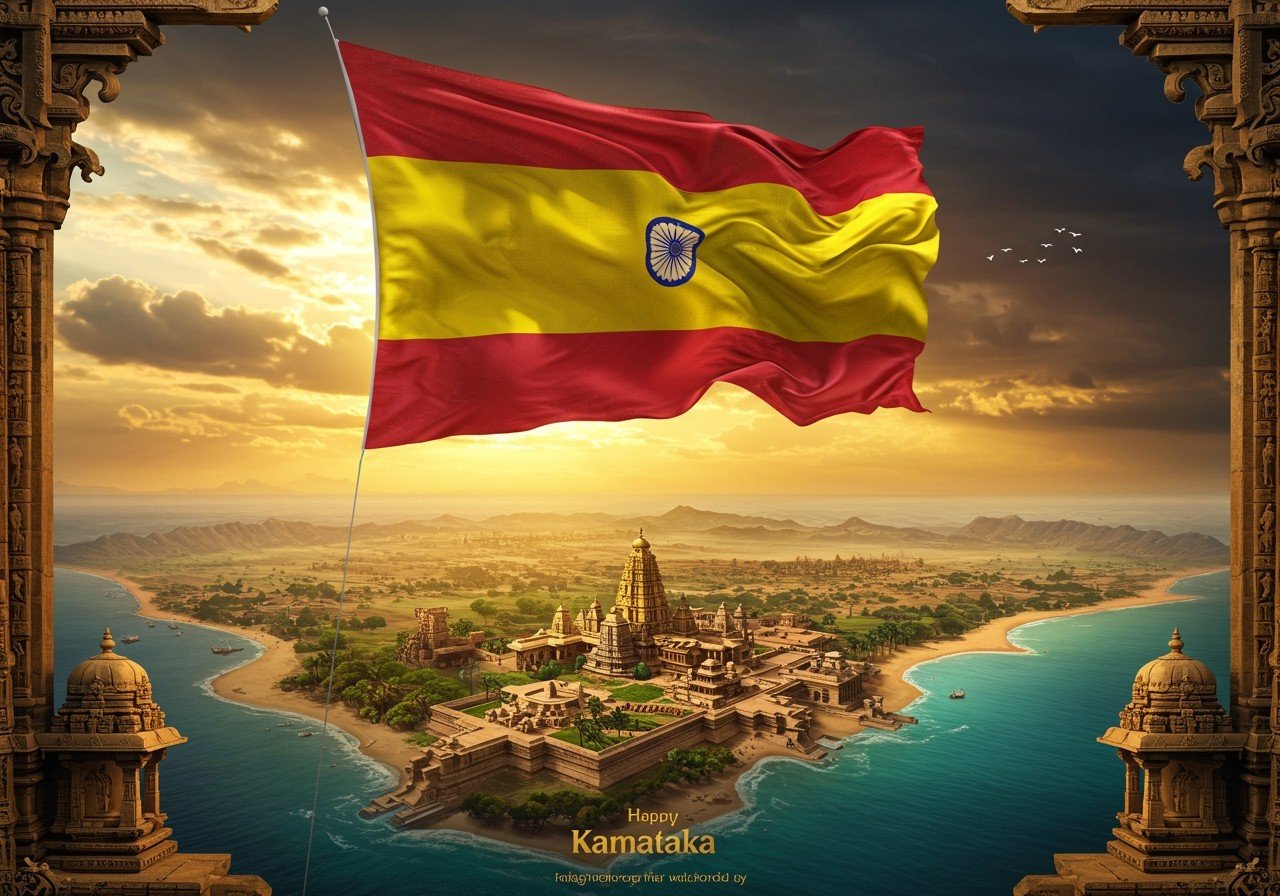
Karnataka, a state in southwestern India, boasts a rich cultural heritage and history. The Karnataka flag, a symbol of pride and unity, has a fascinating history reflecting the state’s political and social evolution. This article explores the origins, significance, and evolution of Karnataka’s flag, offering a comprehensive understanding of its historical context and cultural importance.
Origins of Karnataka’s Flag
The flag of Karnataka, often called the Kannada flag, has roots in the Kannada Movement of the 1960s and 70s. Designed to champion and preserve Kannada language, culture, and heritage, the flag features a tricolour design with a central white band and emblem, based on the traditional bicolour of yellow and red. The bicoloured flag, consisting of yellow and red stripes, symbolizes turmeric and vermilion, representing auspiciousness, well-being, peace, and courage. Conceptualized and designed by Ma Ramamurthy, son of freedom fighter Veerakesari Seetharama Shastri, it served as a unifying symbol for the Kannada-speaking population adopted by various Kannada organizations.
Significance of Colors
The yellow and red colours of the traditional Kannada bicolour hold deep symbolic meanings. Yellow signifies prosperity, well-being, and auspiciousness while red represents courage, sacrifice, and vermilion. These colours have historical significance in Karnataka’s culture:
- Festivals: These colours are prominently used in traditional celebrations like Ugadi and Dasara, adding to the vibrancy and cultural significance of these festivities. The colours often adorn decorations, clothing, and traditional artifacts during these celebrations.
- Rituals: Yellow and red are frequently seen in local ceremonies and religious events, signifying prosperity and courage. They are often incorporated into ritualistic items, decorations, and offerings.
- Art Forms: The symbolic colours are reflected in Karnataka’s vibrant art forms like Yakshagana, a traditional theatre form. Costumes, makeup, and stage settings often feature these colours, highlighting their cultural significance.
Evolution of the Flag
Since its inception, the Karnataka flag has seen some evolution. Initially used by Kannada activists, the current tricolour design with the emblem gained official recognition in 2018. Factors influencing this acceptance include:
- Public Protests: Demonstrations and rallies advocating for official status played a key role in raising awareness and garnering support for the flag’s recognition.
- Government Approvals: The government of Karnataka took steps to formalize the flag in 2018, giving it official status and cementing its place in the state’s identity.
- Prominent Figures: Contributions and advocacy from leaders within the Kannada Movement and other prominent figures helped propel the flag’s journey towards official recognition.
Kalyana Karnataka
Previously known as Hyderabad-Karnataka, this region was renamed Kalyana Karnataka in 2019. This renaming reflects:
- Integration into Karnataka: The name change signifies the region’s complete integration into the state of Karnataka, fostering a sense of unity and shared identity.
- Regional Identity: While integrated, the name change also acknowledges the region’s distinct identity within the larger state of Karnataka.
- Cultural Significance: The renaming has had an impact on the traditions and heritage of Kalyana Karnataka, further emphasizing the region’s unique cultural contributions within the state.
Contemporary Use and Recognition
Today, the Karnataka flag is widely recognized and used in diverse contexts:
- State Festivals: The flag is prominently displayed during important celebrations like Rajyotsava (Karnataka Formation Day), symbolizing state pride and unity.
- Government Functions: It’s used in official state ceremonies and gatherings, representing the government and people of Karnataka.
- Public Gatherings: The flag is seen at various cultural events and protests, serving as a symbol of identity and solidarity.
The flag is also present in educational institutions and sports events, further promoting Kannada pride. Its presence signifies the state’s commitment to its cultural heritage. Find high-quality puja items for your celebrations at poojn.in. Explore our collection of brass idols and ritual items to enhance your cultural celebrations.
Poojn.in: Your Partner in Celebrating Karnataka’s Heritage
Poojn.in, India’s leading online store for cultural and religious goods, offers a wide selection of products perfect for celebrating Karnataka’s rich traditions. Enhance your observance of Rajyotsava and other festivals with authentic puja items from poojn.in. We provide everything you need to express your cultural pride and participate in traditional ceremonies.
Conclusion
Karnataka’s flag is more than just a symbol; it embodies the state’s rich history, cultural identity, and the unity of its people. From its origins in the Kannada Movement to its official recognition, the flag represents the pride and valor of Karnataka. As the state continues to progress, the flag serves as a powerful reminder of its heritage and the enduring spirit of its people, signifying prosperity, courage, and unity.
FAQs on Karnataka’s Flag: A History
What is the history of Karnataka’s flag?
Karnataka’s flag has a rich history intertwined with the state’s cultural and political landscape, serving as a symbol of pride, unity, and the Kannada language movement.
When did the discussions for an official Karnataka flag begin?
Discussions and proposals regarding an official flag for Karnataka have been ongoing since the 1960s, culminating in the official adoption of the current design in 2018.
What does the flag of Karnataka symbolize?
The Karnataka flag, with its tricolour design and emblem, symbolizes the state’s rich heritage, cultural identity, unity, and the enduring spirit of its people. It also draws upon the traditional symbolism of the yellow and red bicolour, representing auspiciousness, well-being, peace and courage.
What is the significance of Ma Ramamurthy in the flag’s history?
Ma Ramamurthy, son of freedom fighter Veerakesari Seetharama Shastri, played a significant role by conceptualizing and designing the yellow and red bicolour, which forms the basis of the current flag’s design and symbolism.
Where can I find more information about the Kannada Movement and the flag’s origins?
Numerous online resources and historical archives offer detailed information about the Kannada Movement, the history of the Karnataka flag, and its evolution over time.


